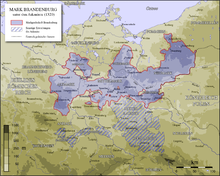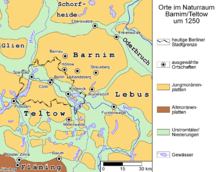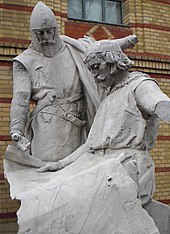John I, Margrave of Brandenburg
| John I | |
|---|---|
Henry I, Margrave of Brandenburg-Stendal Matilda, Duchess of Pomerania Albert of Brandenburg | |
| House | House of Ascania |
| Father | Albert II, Margrave of Brandenburg |
| Mother | Matilda of Lusatia |
John I, Margrave of Brandenburg ( c. 1213 – 4 April 1266) was from 1220 until his death Margrave of Brandenburg, jointly with his brother Otto III "the Pious".
The reign of these two
Before their death, they divided the Margraviate into a Johannine and Ottonian parts. The Ascanians were traditionally buried in the
After the Ottonian line died out in 1317, John I's grandson Waldemar reunited the Margraviate.
Life
Regency and guardianship
John was the elder son of
In 1221, their mother, Countess Matilda, purchased the regency from the Archbishop of Magdeburg for 1900 silver
After Matilda died in 1225, the brothers jointly ruled the Margraviate of Brandenburg. John I was twelve at the time, and Otto III was ten. They were knighted on 11 May 1231 in Brandenburg an der Havel, which is generally taken as the beginning of their reign.[2][3]
Domestic policies

After the death of Count Henry of Brunswick-Lüneburg in 1227, the brothers supported his nephew, their brother-in-law Otto the Child, who was only able to prevail against Hohenstaufen's claims and its vassals by force of arms. In 1229, there was a feud with former regent Archbishop Albert, which ended peacefully. Like their former opponents and defenders, they appeared at the Diet of Mainz in 1235, where the Public Peace of Mainz was proclaimed.
After the dispute over the kingship between
Developing the country

John I and his brother Otto III developed the territory of their margraviate and expanded market towns and castles, including
The Teltow War and the Treaty of Landin
Between 1230 and 1245, Brandenburg acquired the remaining part of
From 1239 to 1245, the brothers fought the
In 1250, the brothers closed the
Policies to stabilize the Neumark
During the first third of the 13th century, German settlers were recruited by Duke
The Margraves used the tried and tested Ascanian policy of founding monasteries and settlements to stabilise their new possessions. As early as 1230, they supported the Polish Count Dionysius Bronisius when he founded the
The historian Stefan Warnatsch has summarized this development and the attempts of the Ascanians to gain access to the Baltic Sea from the middle Oder and the Uckermark as follows: The great success of the territorial expansion in the 13th century was mainly due to the great-grandsons of Albert the Bear. The design of their reign reached much further spatially and conceptually than their predecessors.[6] According to Lutz Partenheimer: [around 1250], the Ascanians had pushed back their competitors from Magdeburg, Wettin, Mecklenburg, Pomerania, Poland and the smaller competitors on all fronts.[4] However, John I and Otto III could have produced a strategically important connection to the Baltic Sea.
Development in the Berlin area
The development of the Berlin area is closely related to the other policies of the two Margraves. The two founding cities of Berlin (
Residence at Spandau

In 1229, the Margraves of Brandenburg lost a battle against their former guardian, the archbishop of Magdeburg at the Plauer See, close to their residence in Brandenburg an der Havel. The escaped to the fortress at Spandau. In the following years, the brothers made Spandau their preferred residence, next to Tangermünde in the Altmark. Between 1232 and 1266, seventeen stays at Spandau have been documented, more than at any other town.[8]
Albert the Bear probably expanded the fortress island at Spandau eastwards before or shortly after his victory against a certain Jaxa (this was probably
Expansion of Cölln and Berlin


According to the current state of research, no evidence has been found that a Slavic settlement existed in the area around the twin towns of Berlin and Cölln.[11] The ford across the largely swampy Berlin Glacial Valley gained importance during the Slavic-German transition period, when John I and Otto III settled the sparsely populated plateaus of Teltow and Barnim with local Slavs and German immigrants.
According to Adriaan von Müller, the strategic importance of Cölln and Berlin, and the reason for the foundation was probably to form a counterweight to Köpenick, a secure trading hub held by the
According to Winfried Schich, we can assume the "Berlin and Cölln owe their development as urban settlements to the structural changes in this area due to the expansion during the High Middle Ages, which led both to a denser population and a reorganization of long-distance trade routes. [...] The diluvial plateaus of Teltow and Barnim with their heavy and relatively fertile soils, were systematically settled and put under the plow during the reign of Margraves John I and Otto III."[13] During the first phase of settlement, the lowland areas along the river with their lighter soils seem to have been the preferred places of settlement.
According to the Chronica Marchionum Brandenburgensium of 1280, Berlin and other places were "built" (exstruxerunt) by John I and Otto III. Since their reign had started in 1225, the period around 1230 is considered the founding period of Berlin. Recent archeological research has uncovered evidence of late 12th century
Among the privileges granted to the two cities by the Margraves were Brandenburg Law (including absence of tolls, free exercise of trade and commerce, hereditary property rights) and in particular the
Inheritance and descendants
The joint rule of the Margraves ended in 1258 with a division of their territory. A cleverly managed division and continued consensual policy prevented the Margraviate from falling apart. The preparations for the reorganization may have begun in 1250, when the Uckermark was acquired, but no later than 1255, when John I married Jutta (Brigitte), the daughter of Duke Albert I of Saxony-Wittenberg.[17]
Johannine and Ottonian line
Chorin Abbey - Grave laying and power politics



The politics of marriage and 1258 consummated division of the state government led to the joint foundation of the monastery of Mariensee on a former island in the Parsteiner See lake on the northeastern edge of today's Barnim. Until then, deceased Margraves of Brandenburg had been buried at Lehnin Abbey, in the Ottonian part of the Margraviate. The monastery of Mariensee was meant to provide the Johannine line with a burial place of their own. Construction of the monastery began in 1258 with monks from Lehnin. Even before Marinesee was completed in 1273, a decision was made to move to a new location approximately five miles to the southwest with the new name Chorin Abbey. When John I died in 1266, he was initially buried at Mariensee. In 1273, his body was moved to Chorin Abbey.[18] It appears that in 1266, John I arranged for the monastery to move and that he donated rich gifts to the new Chorin Abbey, including the village of Parstein. His sons later confirmed these donations for the benefit of their father's soul and their own.[19]
As with all monastery founded by the Ascanians, political and economic considerations played an important rôle, alongside the pastoral aspects. A Slavic circular rampart existed on the island, to the west of the monastery. John I and Otto III probably used this rampart as a castle against their Pomeranian competitors. The monastery was meant to provide central and administrative functions. "Both the foundation itself and the location in a regional centre 'across' the trade route [...] in a populated area are to be interpreted as the result of political calculations".[20]
Dividing the Margraviate
When the Margraviate was divided, John I received
The Ottonian line died out in 1317 with the death of Margrave John V in Spandau, so that Brandenburg was reunited under Waldemar the Great. The Johannine line died out only three years later, with the death of Henry the Child in 1320, ending Ascanian rule in Brandenburg. In 1290, nineteen Margraves of the two lines had gathered on a hill near Rathenow; in 1318 only two Margraves were left alive: Waldemar and Henry the Child.[23] The last Ascanian in Brandenburg, the eleven-year-old Henry the Child, only played a minor rôle and was already at the mercy of the various houses trying to grab power in the upcoming power vacuum.
Marriage and issue
In 1230, John I married Sophie of Denmark (1217–1247), daughter of King Valdemar II of Denmark and Berengaria of Portugal. With her, he had the following children:
- John II of Brandenburg (1237(?)–1281), Margrave of Brandenburg as co-ruler.
- Otto IV of Brandenburg (c. 1238–1308), Margrave of Brandenburg.
- Conrad I of Brandenburg (c. 1240–1304), Margrave of Brandenburg as co-regent, the father of Waldemar, the last Ascanian Margrave of Brandenburg.
- Eric of Brandenburg (c. 1242–1295), Archbishop of Magdeburg from 1283 to 1295.
- Helene of Brandenburg (1241 or 1242 – 1304), married in 1258 to Margrave Dietrich of Landsberg(1242–1285).
- Hermann of Brandenburg (died: probably 1291), Bishop of Havelberg from 1290 onward.
In 1255, John I married Brigitte Jutta of Saxony, the daughter of Albert I, Duke of Saxony and Agnes of Austria (1206–1226). With her, he had the following children:
- Erik V of Denmark (1249–1286), and secondly in 1293 to Gerhard II, Count of Holstein-Plön(1254–1312).
- Landsberg.
- Matilda of Brandenburg (died: before 1309), married to Bogislaw IV, Duke of Pomerania (1258–1309).
- Albert of Brandenburg (c. 1258–1290)
John I held King Eric V prisoner from 1262 to 1264. In 1273, the King of Denmark married John's daughter, Agnes of Brandenburg.
After John's death in 1266, his brother Otto III ruled Brandenburg alone. After Otto's death in 1267, John's son, Otto IV, took over as the senior Margrave.
Double statue of the Brothers at the Siegesallee

The double statue depicted on the left stood in the
The central statue in group 5 was the double statue of John and Otto. On the left was a bust of provost Simeon of Cölln, who was a witness, on 28 October 1237, together with bishop Gernand of Brandenburg, of the oldest deed in which Cölln is mentioned.[24] On the right was a bust of Marsilius de Berlin, the first recorded mayor (Schultheiß) of Berlin. He was simultaneously mayor of Cölln.[25]
The choice of the secular and ecclesiastical leaders of Berlin and Cölln as flanking characters for John and Otto underscores the pivotal rôle the city of Berlin played in the lives of the Margraves in the opinion of Reinhold Koser, the historian who did the research for the Siegesallee. Koser regarded the founding and development of the city as the Margrave's most important policy, more so than the expansion the principality and the founding of the monastery. he was also impressed by the consensus which characterised their joint rule, as presented in the Chronicle of 1280. According to Koser, the sculptor Max Baumbach was responsible for the decision to make the founding of Berlin the central theme of the double statue, rather than the expansion or the founding of the monastery.
John I depicted sitting on a stone, with the city charter of Berlin and Cölln spread across his knees. The younger Otto III stand beside him, pointing to the deed with one hand, while his other arm rests on a spear. The outstretched arms and bowed head suggest the brothers' protection and promotion of the twin cities. The fact that the two young men are depicted as mature men was seen by Koser as legitimized by the right of artistic freedom. Two adolescents would not have been able to adequately express the founding of a future world city, from the perspective of the late 19th century interpretation of history.[26]
The overall architecture of the statue group maintains a romanticism style. According to Uta Lehnert, the two eagles show characteristics of the Jugendstil.[26]
Ancestry
| Ancestors of John I, Margrave of Brandenburg | ||||||||||||||||||||||||||||||||||||
|---|---|---|---|---|---|---|---|---|---|---|---|---|---|---|---|---|---|---|---|---|---|---|---|---|---|---|---|---|---|---|---|---|---|---|---|---|
| ||||||||||||||||||||||||||||||||||||
References
Primary references
- Heinrici de Antwerpe: Can. Brandenburg., Tractatus de urbe Brandenburg, edited and elucidated by Georg Sello, in: 22. Jahresbericht des Altmärkischen Vereins für vaterländische Geschichte und Industrie zu Salzwedel, Magdeburg, 1888, issue 1, p. 3-35, internet version by Tilo Köhn with transcriptions and translation.
- Chronica Marchionum Brandenburgensium, ed. G. Sello, FBPrG I, 1888.
- Schreckenbach, Bibliogr. zur Gesch. der Mark Brandenburg, vols. 1–5, Publications of the State Archive at Potsdam, vol. 8 ff, Böhlau, Cologne, 1970–1986
Secondary references
- Tilo Köhn (publisher): Brandenburg, Anhalt und Thüringen im Mittelalter. Askanier und Ludowinger beim Aufbau fürstlicher Territorialherrschaften, Böhlau, Cologne, Weimar and Vienna, 1997, ISBN 3-412-02497-X
- Helmut Assing: Die frühen Askanier und ihre Frauen, Kulturstiftung Bernburg, 2002, ISBN 3-9805532-9-9
- Wolfgang Erdmann: Zisterzienser-Abtei Chorin. Geschichte, Architektur, Kult und Frömmigkeit, Fürsten-Anspruch und -Selbstdarstellung, klösterliches Wirtschaften sowie Wechselwirkungen zur mittelalterlichen Umwelt, with contributions by Gisela Gooß, Manfred Krause and Gunther Nisch, with extensive bibliography, in the series Die Blauen Bücher, Königstein im Taunus, 1994, ISBN 3-7845-0352-7
- Felix Escher: Der Wandel der Residenzfunktion. Zum Verhältnis Spandau – Berlin. Das markgräfliche Hoflager in askanischer Zeit, in: Wolfgang Ribbe (ed.): Slawenburg, Landesfestung, Industriezentrum. Untersuchungen zur Geschichte von Stadt und Bezirk Spandau, Colloqium-Verlag, Berlin, 1983, ISBN 3-7678-0593-6
- Uta Lehnert: Der Kaiser und die Siegesallee. Réclame Royale, Dietrich Reimer Verlag, Berlin, 1998, ISBN 3-496-01189-0
- Lyon, Jonathan R. (2013). Princely Brothers and Sisters: The Sibling Bond in German Politics, 1100-1250. Ithaca and London: Cornell University Press. ISBN 978-0801451300.
- Uwe Michas: Die Eroberung und Besiedlung Nordostbrandenburgs, in the series: Entdeckungen entlang der Märkischen Eiszeitstraße, vol. 7, Gesellschaft zur Erforschung und Förderung der märkischen Eiszeitstraße (ed.), Eberswalde, 2003, ISSN 0340-3718.
- Adriaan von Müller: Gesicherte Spuren. Aus der frühen Vergangenheit der Mark Brandenburg, Bruno Hessling Verlag, Berlin, 1972, ISBN 3-7769-0132-2
- Lutz Partenheimer: Albrecht der Bär – Gründer der Mark Brandenburg und des Fürstentums Anhalt, Böhlau Verlag, Cologne, 2001, ISBN 3-412-16302-3
- Jörg Rogge: Die Wettiner, Thorbecke Verlag, Stuttgart, 2005, ISBN 3-7995-0151-7
- Winfried Schich: Das mittelalterliche Berlin (1237–1411), in: Wolfgang Ribbe (ed.): Veröffentlichung der Historischen Kommission zu Berlin: Geschichte Berlins, vol. 1, Verlag C.H. Beck, Munich, 1987, ISBN 3-406-31591-7
- Winfried Schich: Die Entstehung der mittelalterlichen Stadt Spandau, in: Wolfgang Ribbe (ed.): Slawenburg, Landesfestung, Industriezentrum. Untersuchungen zur Geschichte von Stadt und Bezirk Spandau, Colloqium-Verlag, Berlin, 1983, ISBN 3-7678-0593-6
- Oskar Schwebel: Die Markgrafen Johann I. und Otto III., in: Richard George (ed.): Hie gut Brandenburg alleweg! Geschichts- und Kulturbilder aus der Vergangenheit der Mark und aus Alt-Berlin bis zum Tode des Großen Kurfürsten, Verlag von W. Pauli’s Nachfolger, Berlin, 1900 Online.
- Harald Schwillus and Stefan Beier: Zisterzienser zwischen Ordensideal und Landesherren, Morus-Verlag, Berlin, 1998, ISBN 3-87554-321-1
- Otto Tschirch: Geschichte der Chur- und Hauptstadt Brandenburg a. d. Havel. Festschrift zur Tausendjahrfeier der Stadt 1928/29, 2 vols, Brandenburg an der Havel, 1928; reprinted: 1936, 1941
- Stephan Warnatsch: Geschichte des Klosters Lehnin 1180–1542, in the series Studien zur Geschichte, Kunst und Kultur der Zisterzienser, vol. 12.1, Lukas Verlag, Berlin, 2000 (also: thesis, Free University, Berlin, 1999), ISBN 3-931836-45-2
Footnotes
- ^ Stefan Warnatsch: Geschichte des Klosters Lehnin ..., p. 62
- ^ brandenburg1260.de Marca Brandenburgensis
- ^ Lyon 2013, pp. 203
- ^ a b Lutz Partenheimer: Albrecht der Bär ..., p. 195
- ^ Uwe Michas: Die Eroberung und Besiedlung ..., p. 41
- ^ Stefan Warnatsch: Geschichte des Klosters Lehnin ..., p. 26
- ISBN 3-932981-33-2
- ^ Felix Escher: Der Wandel der Residenzfunktion. ..., p. 161
- ^ Winfried Schich: Die Entstehung der mittelalterlichen Stadt Spandau. ..., p. 63f
- ^ Nonnendammallee, in: Straßennamenlexikon des Luisenstädtischen Bildungsvereins
- ^ Winfried Schich: Das mittelalterliche Berlin, ... S. 151
- ^ Adriaan von Müller: Gesicherte Spuren ..., p. 114f
- ^ Winfried Schich: Das mittelalterliche Berlin, ... p. 157.
- ^ Winfried Schich: Das mittelalterliche Berlin, ... p. 142 ff and 159
- ^ According to Stich, the deed from 1298 in which Margrave Otto V confirmed the staple right granted by his father and uncle, was at least partially forged on a later date. Nevertheless, the staple right may have been granted by John I and Otto III
- ^ Winfried Schich: Die Entstehung der mittelalterlichen Stadt Spandau. ..., p. 83
- ^ Stefan Warnatsch: Geschichte des Klosters Lehnin ..., S. 64f
- ^ Harald Schwillus and Stefan Beier: Zisterzienser zwischen ..., p. 11, 16
- ^ Wolfgang Erdmann: Zisterzienser-Abtei Chorin. ..., p. 10
- ^ Wolfgang Erdmann: Zisterzienser-Abtei Chorin. ..., S. 7
- ^ Sources do not entirely agree on who received what. For example Marca Brandenburgensis says that The elder (Ottonian) line received the Stendal area in the Altmark, the Havelland, Teltow, Barnim, parts of the Neumark and the cities of Brandenburg an der Havel (Altstadt, i.e. the part North of the river), Berlin and Spandau
- ^ Uwe Michas: Die Eroberung und Besiedlung ..., p. 58
- ^ Stefan Warnatsch: Geschichte des Klosters Lehnin ..., p. 66
- ^ 28. Oktober (year 1237) in: Tagesfakten by the Luisenstädtischer Bildungsverein
- ^ Winfried Schich: Das mittelalterliche Berlin, ... p. 141.
- ^ a b Uta Lehnert: Der Kaiser und ..., p. 115
